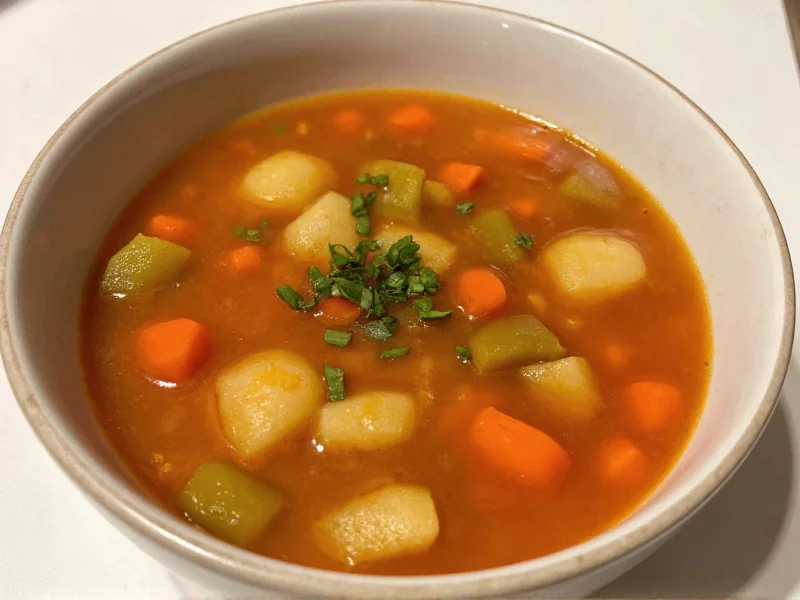Creating a satisfying simple vegetable soup starts with understanding its foundational elements. This versatile dish serves as both a comforting meal and a nutritional powerhouse when prepared correctly. Unlike complex recipes requiring specialty ingredients, a truly simple version focuses on accessible components and straightforward techniques anyone can master.
Essential Ingredients for Basic Vegetable Soup
The magic of simple vegetable soup lies in its minimal ingredient list. You only need six core components to create a flavorful base:
- 1 tablespoon olive oil (or alternative cooking fat)
- 1 large onion, diced
- 2 carrots, sliced
- 2 celery stalks, chopped
- 3 cloves garlic, minced
- 4 cups vegetable broth (low-sodium preferred)
- 1 (14.5 oz) can diced tomatoes
These ingredients form what culinary professionals call the sofrito—the flavor foundation for countless soups worldwide. The onion-carrot-celery combination creates natural sweetness while garlic adds depth without overpowering other elements.
Step-by-Step Preparation Guide
Follow these straightforward steps for perfect results every time:
- Heat olive oil in a 4-quart pot over medium heat
- Add onions, carrots, and celery; sauté for 5-7 minutes until softened
- Stir in garlic and cook for 1 minute until fragrant
- Pour in broth and diced tomatoes with their juice
- Bring to a gentle boil, then reduce heat to low
- Cover and simmer for 20 minutes
- Season with salt, pepper, and preferred herbs
This easy vegetable soup recipe for beginners requires no special equipment beyond standard kitchen pots and utensils. The entire process takes approximately 30 minutes from start to finish, making it ideal for weeknight meals when time matters.
Cooking Variables and Timing
Understanding these critical factors ensures consistent results:
| Component | Optimal Setting | Why It Matters |
|---|---|---|
| Heat Level | Medium to low simmer | Prevents ingredient breakdown and maintains texture |
| Cooking Time | 20-25 minutes | Allows flavors to meld without overcooking vegetables |
| Seasoning Timing | Final 5 minutes | Preserves herb freshness and salt balance |
| Vegetable Size | Uniform 1/2-inch pieces | Ensures even cooking throughout the batch |
Customization Options for Different Diets
One reason this quick homemade vegetable soup works for so many people is its adaptability. Consider these simple modifications:
- Gluten-free: Use certified gluten-free broth (most vegetable broths are naturally GF)
- Vegan: Ensure broth contains no animal products (check labels)
- Low-sodium: Use no-salt-added tomatoes and low-sodium broth
- Protein boost: Add 1 cup cooked beans or lentils during final simmer
- Keto adaptation: Increase healthy fats with avocado slices or olive oil drizzle
Seasonal variations keep this basic vegetable soup interesting throughout the year. In spring, add asparagus and peas; summer brings zucchini and fresh tomatoes; fall works well with squash and sweet potatoes; winter pairs nicely with root vegetables and hearty greens.
Storage and Reheating Best Practices
Proper storage extends your soup's shelf life while maintaining quality:
- Cool completely before refrigerating (within 2 hours of cooking)
- Store in airtight containers for up to 5 days
- Freeze in portion-sized containers for up to 3 months
- Reheat gently on stove over medium-low heat
- Add fresh herbs after reheating for maximum flavor impact
Many home cooks don't realize that vegetable soup often tastes better the next day as flavors continue developing. The acids in tomatoes help preserve other ingredients, making this one of the most freezer-friendly soups.
Nutritional Benefits Without Exaggeration
A standard serving (1.5 cups) of this healthy vegetable soup with minimal ingredients provides:
- Approximately 90-120 calories depending on added fats
- 3-5 grams of dietary fiber supporting digestive health
- Significant vitamin A from carrots (70% of daily value)
- Good source of vitamin C from tomatoes and bell peppers
- Naturally low in saturated fat and cholesterol-free
Unlike processed alternatives, this homemade version contains no artificial preservatives or flavor enhancers. The natural sodium content remains moderate when using low-sodium broth, making it suitable for most dietary plans when consumed as part of balanced eating.
Common Mistakes to Avoid
Even experienced cooks sometimes make these errors with simple vegetable soup:
- Overcooking vegetables: Leads to mushy texture and nutrient loss
- Adding salt too early: Can draw out moisture and affect texture
- Using old broth: Significantly impacts overall flavor quality
- Skipping the sauté step: Misses opportunity to develop flavor complexity
- Overcrowding the pot: Prevents proper vegetable browning
Remember that soup is forgiving—if you accidentally add too much salt, drop in a peeled potato to absorb excess. If it's too thin, simmer uncovered to reduce liquid. These quick fixes make simple vegetable soup an excellent choice for developing cooking intuition.











 浙公网安备
33010002000092号
浙公网安备
33010002000092号 浙B2-20120091-4
浙B2-20120091-4